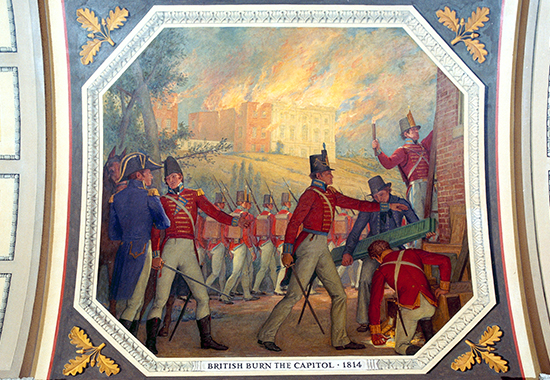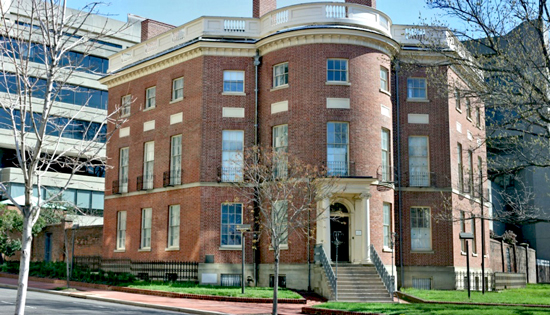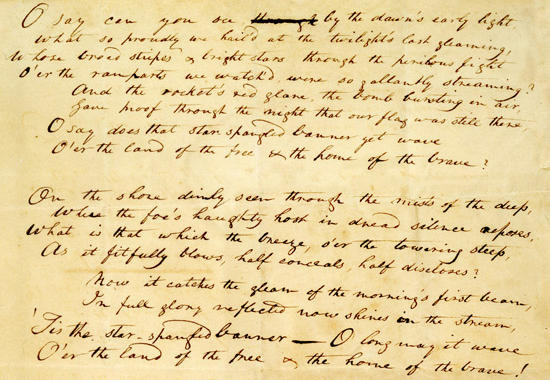|
War of 1812
Timeline: 1814
Go here for the
 War of 1812 in a Nutshell
War of 1812 in a Nutshell
If
these timelines of the War of 1812 are too detailed,
check the
 War
of 1812 - Key Events,
which are a summary of the years
1812-1815. War
of 1812 - Key Events,
which are a summary of the years
1812-1815.
January 5, 1814
Monroe answers Castlereagh's letter from
 November 4, 1813, in which
Britain proposed peace negotiations:
November 4, 1813, in which
Britain proposed peace negotiations:
I am
accordingly instructed to make known to your
Lordship, for the information of His Royal
Highness the Prince Regent, that the
President accedes to his proposition, and
will take the measures depending on him for
carrying it into effect at Gottenburg*,
with as little delay as possible...
*
Gothenburg, Göteborg in Sweden
January
18, 1814
James Madison, "by and with the advice and consent of the Senate,"
announces to have appointed John Quincy Adams,
James A. Bayard,
Henry Clay, and
Jonathan Russell ministers plenipotentiary and
extraordinary of the United States to negotiate and conclude peace
with Great Britain.
Gallatin will be included on
 February 9, 1814.
February 9, 1814.
Bayard and Gallatin are already in
Europe. They had left the States on
 May 9, 1813 for St. Petersburg.
And Adams, of course, has been in St. Petersburg several years now
as the U.S. Minister to Russia.
May 9, 1813 for St. Petersburg.
And Adams, of course, has been in St. Petersburg several years now
as the U.S. Minister to Russia.
The rest of the peace commission, Clay
and Russell, will depart from
the United States on February 25, 1814.
January 22, 1814
Battle of Emuckfau Creek. Andrew
Jackson fights the Red Sticks. Draw.
January 24, 1814
Battle of Enitochopco. Andrew
Jackson fights the Red Sticks once more. Another draw.
January 25, 1814
Having been at St. Petersburg since July 21, 1814, it becomes clear
to Bayard and Gallatin that Great Britain is not going to accept
Russia's offer of mediation.
Bayard and Gallatin leave St. Petersburg direction Amsterdam via
Berlin. They will arrive in Amsterdam on
 March 4, 1814.
March 4, 1814.
January 27, 1814
Battle of Calabee Creek.
U.S. victory. Red
Sticks surprise John Floyd and his men at their camp in a pre-dawn
attack. After initial confusion, Floyd and friendly Creeks rout the
Red Sticks. However, Floyd will return to Fort Mitchell and the Red
Sticks will reclaim the battlefield.
February
9, 1814
Albert Gallatin is appointed by the President and confirmed by the
Senate to join the peace commission that has been announced on
 January 18, 1814. The
commission will leave for Europe on
January 18, 1814. The
commission will leave for Europe on
 February 25, 1814. Adams,
Bayard, and Gallatin are already in Europe.
February 25, 1814. Adams,
Bayard, and Gallatin are already in Europe.
February
25, 1814
Clay and Russell depart from the United States direction Gottenburg,
Sweden. They will arrive on
 April 14, 1814.
April 14, 1814.
March 4, 1814
Bayard and Gallatin arrive at Amsterdam. They had left St.
Petersburg on
 January 25, 1814. They continue
their journey and will arrive at London on
January 25, 1814. They continue
their journey and will arrive at London on
 April 10, 1814.
April 10, 1814.
March 27, 1814
Battle of Horseshoe Bend (Tohopeka).
Jackson and allied Creek defeat Red Sticks on the Tallapoosa River.
Enormous carnage. Jackson's side sustains 200 casualties, his Creek
enemies 800.
The Creek War ends.
March 28, 1814
HMS Phoebe and Cherub vs. USS Essex. British
victory. The Essex
surrenders 3 miles from Valparaiso, Chile.
March 30, 1814
Second Battle of La Colle Mill,
also spelled Lacolle Mill.
Draw. Americans, led by Maj. Gen. James Wilkinson, attack the British, who
had done a good job of fortifying their position at La Colle Creek.
The onslaught was unsuccessful and the Americans withdraw to
Plattsburg (Plattsburgh.) This is Wilkinson's last battle.
The First
Battle of Lacolle Mill had been fought on November 20,
1812.
April 1, 1814
At St. Petersburg,
 John Quincy Adams gets notified
that he is expected at Ghent (Belgium) to negotiate a peace treaty
for the War of 1812.
John Quincy Adams gets notified
that he is expected at Ghent (Belgium) to negotiate a peace treaty
for the War of 1812.
April 6, 1814
 Napoleon
abdicates. It will turn out to be his first abdication. June 22,
1815, will mark his second and final abdication.
Napoleon
abdicates. It will turn out to be his first abdication. June 22,
1815, will mark his second and final abdication.
Check this event in the
 Timeline of the Napoleonic Wars.
Timeline of the Napoleonic Wars.
April 10, 1814
Bayard and Gallatin arrive at London from Amsterdam. They had left
St. Petersburg on
 January 25, 1814.
January 25, 1814.
April 14, 1814
Clay and Russell arrive at Gottenburg. They commenced their journey
on
 February 25, 1814.
February 25, 1814.
April 29, 1814
USS Peacock vs. HMS Epervier. U.S. Victory. -The Epervier
surrenders to the Peacock, under Lewis Warrington.
May 5 - 6, 1814
Battle of Oswego. British
victory. The British, led by Victor Fisher, attack the
Americans at Oswego. With naval help from Commodore Yeo on the
second day, they drive the Americans from their post.
May 13, 1814
Bayard and Gallatin meet with Castlereagh at London. They introduce
themselves as part of the U.S. peace commission, and tell him that
they are on their way to the peace negotiations at Gottenburg.
A few days later, Bayard and Gallatin
receive a message from Bathurst, who suggests to hold the
negotiations at Ghent instead of Gottenburg, to which they agree.
Ghent became possible because Napoleon
abdicated on April 6, 1814.
 Check this event in the timeline of the
Napoleonic Wars.
Check this event in the timeline of the
Napoleonic Wars.
May 15, 1814
The Americans, led by Colonel John B. Campbell, take the village of
Dover, also called Dover Mills, today's Port Dover, and burn it to
the ground.
May 23, 1814
Bayard leaves London for Paris. His final destination is Ghent.
May 28, 1814
Bayard arrives at Paris. He will leave on June 15, 1814, for Ghent.
May 30, 1814
Battle of Sandy Creek. The British attack the Americans at Sandy
Creek but lose this battle.
June 15, 1814
Bayard leaves Paris for Ghent.
June 27, 1814
Bayard arrives at Ghent. Adams and Russell are already there. Clay
and Gallatin will join them in a few days. The British minister,
however, will not arrive until August 6, 1814.
June 28, 1814
USS Wasp vs. HMS Reindeer. U.S. victory. The Wasp, under Capt.
Johnston Blakely, took their prisoners and set the Reindeer on fire.
July 3, 1814
First Battle of Fort Erie. The British surrender their fort to the
Americans, led by Brig. Gen. Winfield Scott, and Brig Gen. Eleazar
Ripley.
The Second
Battle of Fort Erie will be fought on August 15, 1814.
July 5, 1814
The Battle of Chippewa, a US victory.
July 17 - 18, 1814
The British attack and take Fort Shelby / Prairie du Chien. The
Americans surrender on July 18, 1814.
July 25, 1814
The Battle of Lundy's Lane ends with a draw.
August 3, 1814
Battle of Conjocta Creek. U.S.
victory. Americans, led by Major Lodowick Morgan,
ambush the British, led by Tucker, at Conjocta Creek.
Also on August 3, 1814 - The British
take Hampden, Maine
August 6, 1814
The British peace commission arrives at Ghent. Its three
commissioners are William Adams,
James Gambier, and
Henry Goulburn.
This is Britain's B-team, and it will
show during negotiations. Meanwhile, Britain's A-team is on their
way to the
 Congress of Vienna.
Congress of Vienna.
 Check this event in the timeline of the
Napoleonic Wars.
Check this event in the timeline of the
Napoleonic Wars.
August 8, 1814
Negotiations between British and American diplomats at Ghent begin. These will last until December 24, 1814, and will result
in the
 Treaty of Ghent.
Treaty of Ghent.
Meeting at Ghent, then under French
administration, has become possible because Napoleon abdicated on
April 6, 1814.
 Check this event in the timeline of the
Napoleonic Wars.
Check this event in the timeline of the
Napoleonic Wars.
August 9, 1814
Treaty of Fort Jackson. Jackson
forces all tribal leaders to sign his Treaty of Fort Jackson, in
which everyone agrees to give the whites another 36,000 square miles
of land. Interestingly, Jackson also forces allied Indians to sign.
August 9 - 12, 1814
Battle of Stonington,
Connecticut. U.S. victory. British bombardment of Stonington. Surprisingly, the
British withdraw after four days of heavy fire.
August 13, 1814
Second Battle of Fort Erie. The British try to retake Fort Erie and open
artillery fire. This battle will be decided on August 15, 1814. But
the British will besiege the Fort until September 17, 1814.
The First
Battle of Fort Erie took place on July 3, 1814.
August 14, 1814
With permission from the Spanish landlords, the British enter
Pensacola. The objective is to free Mobile, which has been occupied
by U.S. troops since
 April 12, 1813.
April 12, 1813.
August 15, 1814
At 2.30 a.m., Lt. Col. Victor Fischer leads 1,300 British troops in
a surprise attack on Fort Erie. However, the Americans were
expecting them. But more importantly, a powder magazine exploded,
killed the entire British assault force, and decided the battle in
favor of the Americans.
August 19, 1814
British troops land at
Benedict, Maryland, on the shores of the Patuxent River.
August 24, 1814
Battle of Bladensburg. The British rout the Americans.
August 24-25, 1814
The British haven't forgotten the
 Battle of York. At Washington,
they shuffle down Pennsylvania
Avenue and set fire to the White House, the Capitol, and
all public buildings. Private property was off limits. They are led
by Robert Ross and
George Cockburn.
Battle of York. At Washington,
they shuffle down Pennsylvania
Avenue and set fire to the White House, the Capitol, and
all public buildings. Private property was off limits. They are led
by Robert Ross and
George Cockburn.
The Capitol,
shown ablaze in the background, was
gutted, and only a sudden rainstorm
prevented its complete destruction.
Architect
of the Capitol

British Burn the Capitol, 1814
Oil on Canvas by Allyn Cox in 1973-1974
Photograph taken on October 12, 2011, in the Cox Corridors, Capitol
United States Government Work
Architect of the Capitol
President
Madison and the First Lady will temporary move
into the Octagon House, Washington. Here she
stands:

Octagon House,
located at 18th St. and New York Ave.,
Northwest, Washington, D.C.
American
Institute of Architects
The American
Architectural Foundation tells you:
In August
1814, during the War of 1812, the British
burned many public buildings in Washington,
including the U.S. Capitol and the
President’s House (now the White House).
President and First Lady Dolley Madison
rented The Octagon from the Tayloes (for
$500 per month), which had escaped the
flames. The French minister Louis Serurier,
at the request of Mrs. Tayloe, declared the
property French territory, flew the French
flag, and notified the British, thus
ensuring additional safety for the building.
The Madisons resided here for six months and
it was in the second floor parlor on
February 17, 1815 that the Treaty of Ghent
ending the war was signed by the President.
Here is a
 picture of Madison's study,
the room above the entrance, in which he will
sign the Treaty of Ghent.
picture of Madison's study,
the room above the entrance, in which he will
sign the Treaty of Ghent.
August 30, 1814
Battle of Caulk's Field.
Draw. American militia
fight British sailors on land. British captain
of the HMS Menelaus, Sir Peter Parker, is
mortally wounded.
September 1, 1814
USS Wasp vs. HMS Avon. The Avon
sinks.
September 6, 1814
Battle of Beekmantown, NY. British
victory. U.S. volunteers from Plattsburgh accompany
major general of militia Benjamin Mooers to Beekmantown, NY,
where they encounter the British invasion forces
and are pressed
backwards to the Saranac River (Plattsburgh.)
Here, with the Americans on the other side of
the river, the British take a breather.
Although the
British forces are superior in number, the U.S.
militia fought well, and are promised a shiny
rifle by Major General Alexander Macomb. But
paperwork takes its time and they won't receive
it until 1822.
September 7, 1814
Aboard the HMS Tonnant, Maj. Gen. Robert
Ross gives permission to release Dr. William
Beanes, after negotiations with Francis Scott
Key and U.S. deputy for prisoner exchange,
Col. John Skinner. However, they are ordered to stay onboard
because of the imminent attack on Baltimore.
They will be free to go on September 14, 1814.
September 11, 1814
The Battle of Lake Champlain,
at which the U.S. naval forces under Thomas Macdonough
defeat a larger British force. Meanwhile on land was fought the
Battle of Plattsburg,
also a U.S. victory.
September 12, 1814
Battle of North Point,
British victory. Also called first day of the
Battle
of Baltimore. The British defeat the
Americans but at great cost.
British
Maj. Gen. Robert Ross
is shot off his horse by an American sniper. A bullet passed through
his right arm into his breast. He dies as he is
being carried back to the boats.
Colonel Arthur Brooke
takes command.
The Battle of
Baltimore will be fought until September 14,
1814.
September 13, 1814
Attack on Fort McHenry, or
Second day of the Battle
of Baltimore.
In order to aid the British ground attack on
Baltimore, the British navy has to get past Fort
McHenry, which protects the harbor of Baltimore.
The British
commence a 25-hour-non-stop-bombardment of Fort McHenry.
Defending the fort are 1,000 troops under the
command of
Major George Armistead.
September 14, 1814
Third and final day of the Battle of Baltimore.
After 25 hours of bombardment, the British
withdraw from the vicinities of
Baltimore, much to the delight of the Americans.
Although the
British won the first attack on September 12,
1814, the Battle of Baltimore ends in a draw.
In the morning,
 Francis Scott Key,
discovering that the Americans had successfully
defended the fort, is inspired to write the
words to The Star-Spangled Banner.
Francis Scott Key,
discovering that the Americans had successfully
defended the fort, is inspired to write the
words to The Star-Spangled Banner.

Earliest Known Manuscript of Key's Song
It is
probably one of several drafts that Key made
before sending the copy to the printer.
Maryland
Historical Society
Also September 14,
1814: First day of the
First
Battle of Fort Bowyer, Mobile Bay. A
combined force of 225
British marines and their Indian allies launch a
land attack to take Fort Bowyer, but are
repulsed.
September 15, 1814
Second and last day of the
First Battle of Fort Bowyer. For two
hours, the British bombard the fort from sea.
Eventually, one of their vessels, the HMS
Hermes, runs aground. The British retreat.
U.S. victory.
British
casualties: 32 killed, 40 wounded. Other sources
say 50 killed and wounded. The British commander
William Henry Percy, captain of the HMS
Hermes, did not die in this battle.
He lived 1788–1855. But he did order the
Hermes to be burnt so that it won't fall in
enemy hands.
U.S. casualties: 4 killed, 4 wounded.
The British will
be more successful at the
 Second Battle of Fort
Bowyer on February 11, 1815.
Second Battle of Fort
Bowyer on February 11, 1815.
September 17, 1814
U.S. Sortie from Fort
Erie. U.S. victory.
U.S. Brig. Gen Peter Porter leads two columns
out of Fort Erie. This ends the Siege of Fort
Erie and marks the beginning of Izard 's
offensive.
October 9, 1814
This is the last time anyone saw the USS Wasp.
It was sighted today by the Swedish brig
Adonis. After this Wasp disappears
will all on board. Nobody knows when and where
exactly.
October 19, 1814
Battle of Cook's Mills. Draw.
November 5, 1814
The Americans judge Fort Erie too difficult to
defend and blow it up.
November 7, 1814
The Americans, led by Andrew Jackson, take Pensacola. The British,
who had set up camp in town with Spanish
permission since August 14, 1814, have
withdrawn, and the Spanish surrender.
Jackson falls back
to Mobile where he expects the British to attack
next. When the assault does not materialize, he
assumes the British target New Orleans instead.
December 1, 1814
Jackson and his army arrives at New Orleans.
December 13, 1814
Major General William Carroll and 3,000 troops
arrive at New Orleans.
December 14, 1814
Battle of Lake Borgne.
British victory. Although the British won this
battle, it will delay their advance on New
Orleans, giving the U.S. more time to prepare.
December 15, 1814
The
 Hartford Convention begins. It will
last until January 5, 1815.
Hartford Convention begins. It will
last until January 5, 1815.
December 23, 1814
Battle at Villeré Plantation.
Draw. The Villeré plantation is located on the
Mississippi River eight miles below New Orleans.
The (now former) plantation owner's name is
Major Jacques Philippe Villeré. His son manages
to escape and warn Jackson of the British
advance.
Although this
battle is a draw, the British will stay at the
plantation and will use it as their headquarters
until their evacuation from Louisiana on January
19, 1815.
December 24, 1814
The
 Treaty of Ghent is signed at Ghent, Belgium.
Negotiations had begun on August 8, 1814.
Treaty of Ghent is signed at Ghent, Belgium.
Negotiations had begun on August 8, 1814.
Now that peace is restored, the United States
wish to renew commercial relations with Great
Britain. Before coming back to the States,
Adams, Clay, and Gallatin are instructed to go
to London and to negotiate a trade treaty.
More History
|